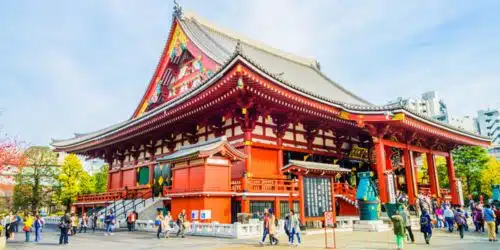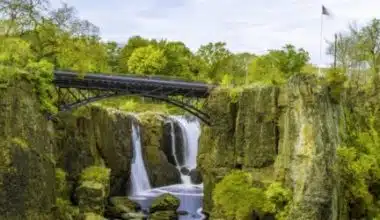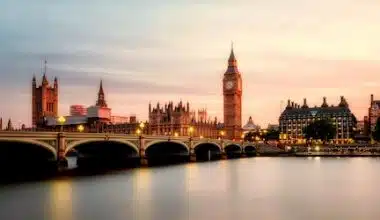Japan is a nation with several museums and offers something for everyone, just like the rest of the nation’s cultural offerings. You can find what interests you in the Land of the Rising Sun, whether you’re a traditional museum aficionado looking for an overview of Japanese culture, a history nerd wishing to delve into Japan’s past, or an eclectic traveler looking for something different. Here are some suggestions for museums in Japan to help you on your way.
Museums In Japan
Japan is home to a wide range of museums that cater to various interests. Museums in Japan are a captivating world of art, history, science, and technology that Japan has meticulously preserved and curated. From the timeless beauty of ancient artifacts to the mind-bending wonders of futuristic exhibits, Japan’s museums provide a window into the country’s past, present, and future.
List of Museums In Japan
These are some museums in Japan
#1. Tokyo National Museum
This museum is Japan’s first, oldest, and largest museum, displaying a vast collection of primarily Japanese artworks for 150 years now. It has a collection of more than 100,000 pieces, hundreds of them national treasures, making it one of the biggest and best art and history museums in Japan.
#2. Hiroshima Peace Memorial Museum
This museum is dedicated to the atomic bombing of Hiroshima and its aftermath. It has exhibits that showcase the horrors of the bombing and the efforts towards peace and nuclear disarmament.
#3. Hakone Open-Air Museum
This museum is located in the scenic Hakone area and has a large collection of outdoor sculptures. It also has indoor galleries that showcase modern and contemporary art.
#4. Edo Tokyo Museum
The Edo Tokyo Museum is dedicated to the history and culture of Tokyo during the Edo period (1603–1868). It has exhibits that showcase the life and culture of the people during that time.
#5. Ghibli Museum
This museum is dedicated to the works of Studio Ghibli, a famous Japanese animation studio. It has exhibits that showcase the process of animation and the history of the studio.
#6. Kofukuji National Treasure Museum
The three-faced, six-armed Ashura Statue, one of the most well-known Buddhist statues in Japan, is situated in this Nara museum’s impressive collection of Buddhist artwork.
#7. Adachi Museum of Art
This museum is located in Shimane and has a large collection of contemporary Japanese art. It is also known for its beautiful Japanese gardens.
#8. Kubota Itchiku Art Museum
Kubota Itchiku, a well-known Japanese textile artist, has a collection of his works in this Yamanashi museum.
#9. National Art Center, Tokyo
This museum is located in Roppongi and has a large collection of modern and contemporary art from Japan and around the world.
#10. Toyota Museum of Industry and Technology
The history of the Toyota Motor Corporation and the growth of the Japanese manufacturing industry are both highlighted in the displays of this museum, which is situated in Nagoya.
Art Museums In Japan
The art museums in Japan are where creativity comes to life. There are a lot of things to explore in the world of art, from ancient traditions to contemporary masterpieces. Japan has a thriving art scene, and many museums throughout the country showcase a wide range of art.
These art museums in Japan showcase the country’s rich artistic heritage.
#1. Mori Art Museum, Tokyo
This museum is located on the 52nd and 53rd floors of the Roppongi Hills building in Tokyo and primarily focuses on contemporary works by prominent Asian artists. The museum stages temporary exhibitions and has a collection of around 400 pieces by creatives from Japan and the Asia-Pacific region.
#2. Fukuoka Asian Art Museum
The largest collection of Asian art in the world is housed in this Fukuoka museum. Along with frequently changing temporary exhibitions, it features a permanent collection of some 3,000 works of modern and contemporary art that are rotated.
#3. Adachi Museum of Art
This museum is located in Yasugi and is known for its beautiful Japanese gardens. It has a large collection of contemporary Japanese art.
#4. Hokusai Museum, Obuse
The famed Japanese artist Katsushika Hokusai, known for his woodblock prints, has a selection of his works on display in this museum, which is situated in the town of Obuse.
#5. Tokyo Metropolitan Art Museum
This Ueno Park museum houses a collection of Japanese and Western artwork that includes pieces by well-known artists like Monet and Renoir.
#6. Hakone Open-Air Museum
This museum in Kanagawa has a large collection of outdoor sculptures. It also has indoor galleries that showcase modern and contemporary art.
#7. Museum of Contemporary Art, Tokyo
A collection of modern art from Japan and other countries may be found in this museum, which is located in Kiyosumi.
#8. Chichu Art Museum
Chichu Art Museum was designed by the architect Tadao Ando. It has a collection of contemporary art, including works by Claude Monet and James Turrell.
#9. Ohara Museum of Art
The oldest museum of Western art in Japan is the Ohara Museum of Art, which is situated in Kurashiki. The collection includes pieces by well-known artists such as El Greco, Gauguin, and Monet.
#10. Museum of Modern Art, Kamakura & Hayama
This museum is located in Kamakura and Hayama and has a collection of modern and contemporary art, including works by Jackson Pollock and Mark Rothko.
Best Museums In Japan
The best museums in Japan offer a rich cultural and artistic heritage, and there are many. Whether you’re interested in traditional art, history, or contemporary works, Japan has something to offer everyone. Japan’s top museums include the Tokyo National Museum, the Hiroshima Peace Memorial Museum, the Yayoi Kusama Museum, the Hakone Open-Air Museum, and the TeamLab Museum. These museums showcase various art forms, historical and contemporary, and offer unique experiences for visitors. Japan’s rich cultural heritage makes it an ideal destination for art enthusiasts.
Features of the Best Museums in Japan
#1. Unique Architecture
Many of the best museums in Japan feature interesting and innovative building designs that blend well with the surrounding environment. Examples include the Miho Museum, which integrates structures into the natural surroundings, and the Edo Tokyo Museum, which has a unique building design.
#2. Art and Nature
The mingling of art and nature is a key feature of Japanese culture, and several museums in Japan showcase this connection. Museums like the Hakone Open-Air Museum and the Mori Art Museum balance the beauty of art with stunning natural scenery.
#3. Comprehensive Collections
National museums in Japan, such as the Tokyo National Museum, Kyoto National Museum, Nara National Museum, and Kyushu National Museum, house impressive collections of art and artifacts. These museums often feature a vast array of pre-modern and prehistoric works.
#4. Contemporary Art
Japan also boasts several contemporary art museums, such as the TeamLab Museum and the Yayoi Kusama Museum. These museums offer immersive and interactive experiences, showcasing digital art, light installations, and innovative exhibits.
#5. Rotating Exhibits
Some museums, like the Yayoi Kusama Museum, frequently change their exhibits, ensuring that visitors always have something new to see. This approach keeps the museum dynamic and highly sought-after.
The Hiroshima Peace Memorial Museum focuses on documenting the devastating impact of the atomic bombing and promoting peace. It provides a moving experience that raises awareness about the consequences of war.
#7. Special Exhibitions
Many top museums in Japan, such as the Tokyo National Museum and the Mori Art Museum, host special exhibitions throughout the year. These exhibitions showcase various aspects of Japanese and Asian culture, providing visitors with a unique and ever-changing experience.
#8. Integration of History
Museums like the Edo Tokyo Museum focus on specific historical periods, such as the Edo Period (1603-1868). They provide a comprehensive understanding of the history and culture of Japan during that era.
#9. Promotion of Local Culture
Some Japanese museums, like the Upopoy Ainu National Museum, are dedicated to preserving and promoting specific regional cultures, such as Ainu culture. These museums offer insights into the traditions, lifestyles, and art forms of local communities.
#10. Weird and Wonderful Exhibits
Museums in Japan feature specialized collections, such as the Yokohama Doll Museum, which showcases a wide variety of dolls, or the Cup Noodles Museum, dedicated to the history of instant ramen.
Museums In Japan Tokyo
Tokyo is home to many museums that showcase the country’s rich cultural heritage. The museums are a vibrant tapestry that weaves together traditional Japanese culture, contemporary art, history, and technology. As one of the world’s most dynamic metropolises, Tokyo boasts a diverse range of museums that cater to a wide spectrum of interests. The Tokyo National Museum, Japan’s oldest and largest, houses over 100,000 pieces of primarily Japanese artwork. Other notable museums include TeamLab Planets Tokyo, Nezu Museum, Edo-Tokyo Museum, National Museum of Nature and Science, Miori Art Museum, Intermediatheque, Meiji University Museum, Meguro Parasitological Museum, and Tokyo Waterworks Historical Museum.
What the Museums in Tokyo Offer Its Visitors
#1. Cultural Enrichment
Museums in Tokyo offer a deep dive into Japanese history, art, and culture. Visitors can gain a better understanding and appreciation of Japan’s rich heritage through the wide range of exhibits and collections.
#2. Artistic Masterpieces
Tokyo is home to numerous art museums that showcase world-renowned artworks. Visitors can see masterpieces by renowned artists such as Claude Monet, James Turrell, and Walter De Maria, among others.
#3. Architectural Marvels
Some museums in Tokyo are architectural marvels themselves. The designs of these buildings, such as the Chichu Art Museum by Tadao Ando, blend harmoniously with their surroundings and provide a unique experience for visitors.
#4. Educational Opportunities
Museums in Tokyo often offer educational programs, workshops, and guided tours. These opportunities allow visitors, especially students, to learn in-depth about various subjects, including history, art, and science.
#5. Special Exhibitions
Many museums in Tokyo host special exhibitions that feature unique and rare collections. These exhibitions showcase diverse themes and offer a chance to see artifacts and artworks that may not be on permanent display.
#6. Discounts and Membership
Some museums in Tokyo offer discounts on admission tickets for students, and seniors, and certain memberships. These benefits make visiting museums more accessible and affordable.
#7. Integration of Nature
The design of some museums in Tokyo incorporates nature, creating a harmonious blend between the museum and its surroundings. This integration allows visitors to enjoy the beauty of both the artwork and the natural environment.
#8. Preservation of History
Museums in Tokyo play a vital role in preserving and showcasing Japan’s historical artifacts and cultural heritage. They ensure that future generations can learn about and appreciate the country’s past.
#9. Multimedia and Interactive Exhibits
Many museums in Tokyo utilize multimedia technology and interactive exhibits to engage visitors. These interactive displays provide a hands-on learning experience and make the museum visit more engaging and enjoyable.
#10. Convenience
Tokyo has a high concentration of museums, making it easy for visitors to explore multiple museums in one area. This convenience allows visitors to maximize their museum-going experience and discover a wide range of exhibits.
What is the biggest Museum in Japan?
The Tokyo National Museum is the oldest and largest museum in Japan, making it the biggest museum in the country. It houses a vast collection of over 120,000 art and archaeological objects from Japan and other parts of Asia. The museum showcases a wide range of artifacts, including paintings, sculptures, calligraphy, metalware, swords, pottery, and archaeological objects.
Are Museums In Tokyo Free?
Several museums in Tokyo offer free admission. Examples include the Tokyo National Museum, National Museum of Modern Art, Tokyo (MOMAT), The National Art Center, Tokyo, Edo-Tokyo Museum, Ghibli Museum, and the Advertising Museum Tokyo. However, it’s important to note that while these museums may offer free admission for specific groups or on certain days, special exhibitions or events may have separate admission fees.
What Is The Most Expensive Museum In Japan?
The most expensive museum in Japan is the Otsuka Museum of Art. However, it is worth noting that the uniqueness of this museum lies in the fact that none of the art in its collection is original. The charm of the museum lies in its display of high-quality replicas of famous artworks. The admission fee for adults is reported to be 3,150 yen ($29.22).
What Is The Tokyo National Museum Known For?
The Tokyo National Museum is known for being an extraordinary museum that chronicles Japanese culture and history. As the oldest and largest museum in Japan, it boasts a comprehensive collection of Japanese cultural assets. The museum showcases a wide range of art and artifacts, including paintings, sculptures, calligraphy, metalware, swords, pottery, and archaeological objects. It is especially renowned for its displays depicting the art and history of Japan and Asia. The Tokyo National Museum is located in Ueno Park.
What Country Has The Largest Museum In The World?
The country with the largest museum in the world is Russia. The State Hermitage Museum in St. Petersburg is considered the largest art museum in the world in terms of gallery space. It covers an area of 719,480 square feet and houses over 3 million items in its collection, including masterpieces of Western European art, Asian art, and artworks from various periods and cultures. The State Hermitage Museum is a renowned tourist attraction and one of the most visited museums globally.
Conclusion
Japan has a rich cultural heritage, and its museums are a testament to its history and art. Art museums in Japan showcase the country’s rich artistic heritage, showcasing various art forms from ancient traditions to contemporary masterpieces. Japan’s top museums showcase a rich cultural and artistic heritage, including traditional art, history, and contemporary works. Some museums also focus on specific historical periods, regional cultures, and unique exhibits, making them an ideal destination for art enthusiasts. Wherever you are traveling, you are sure to discover one of these fantastic museums nearby since we have personally chosen ten of the top museums in Japan, from Tokyo to Kagoshima.
Best Japan Tour Packages In 2023






